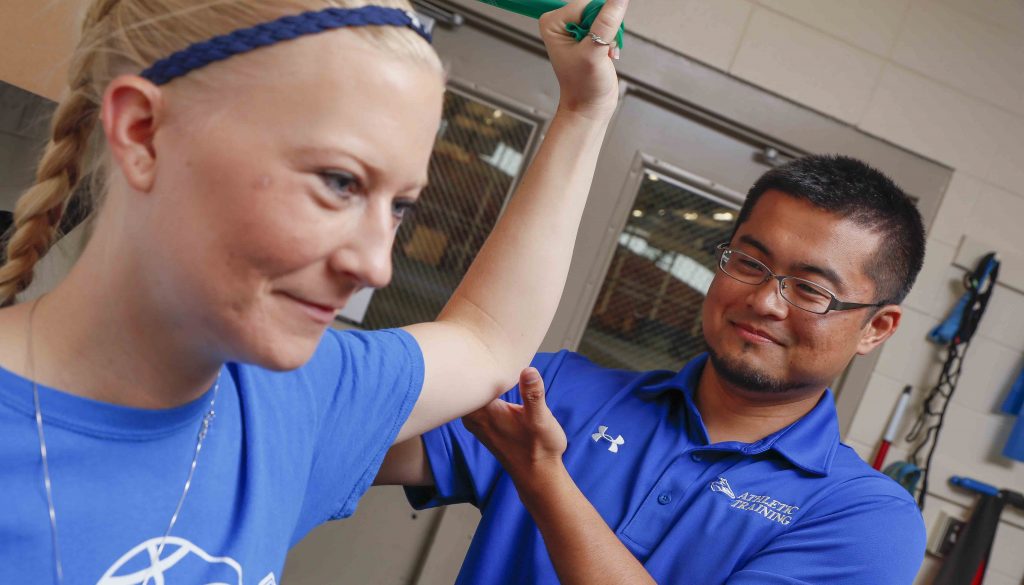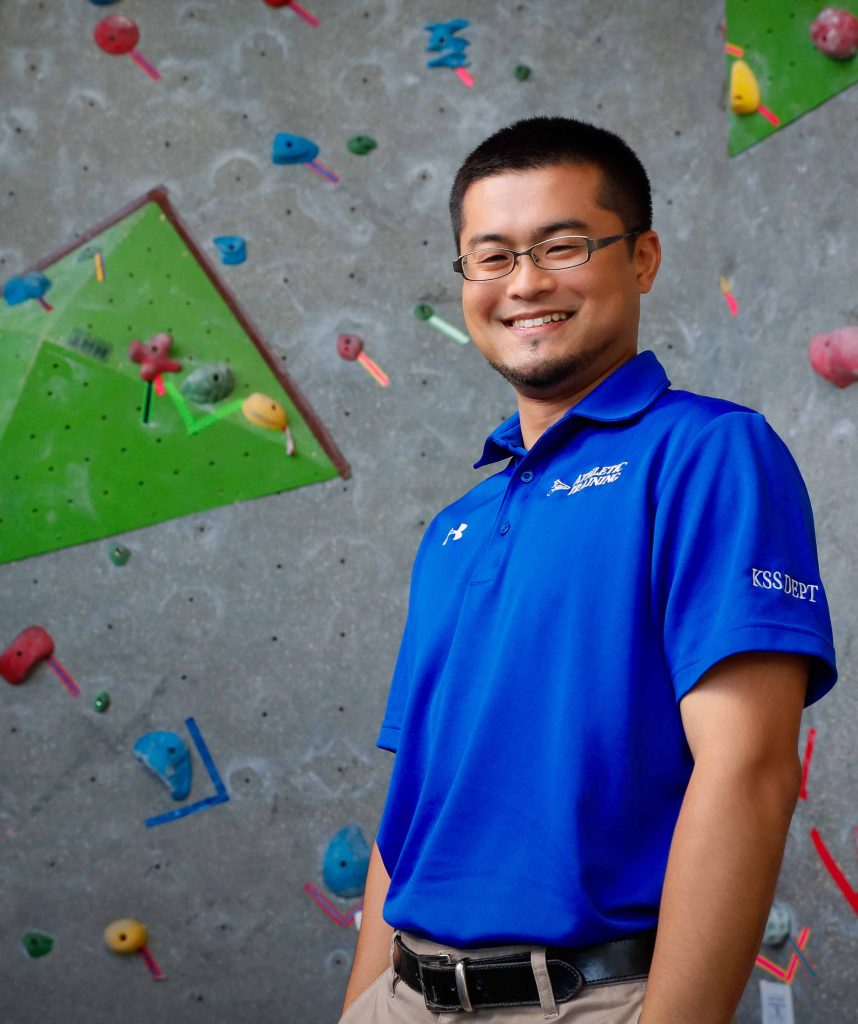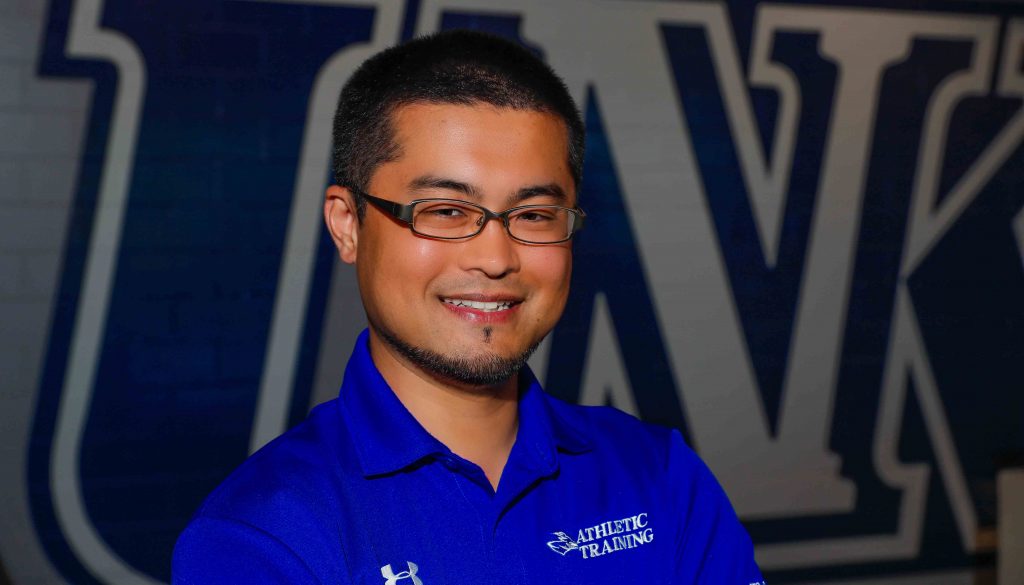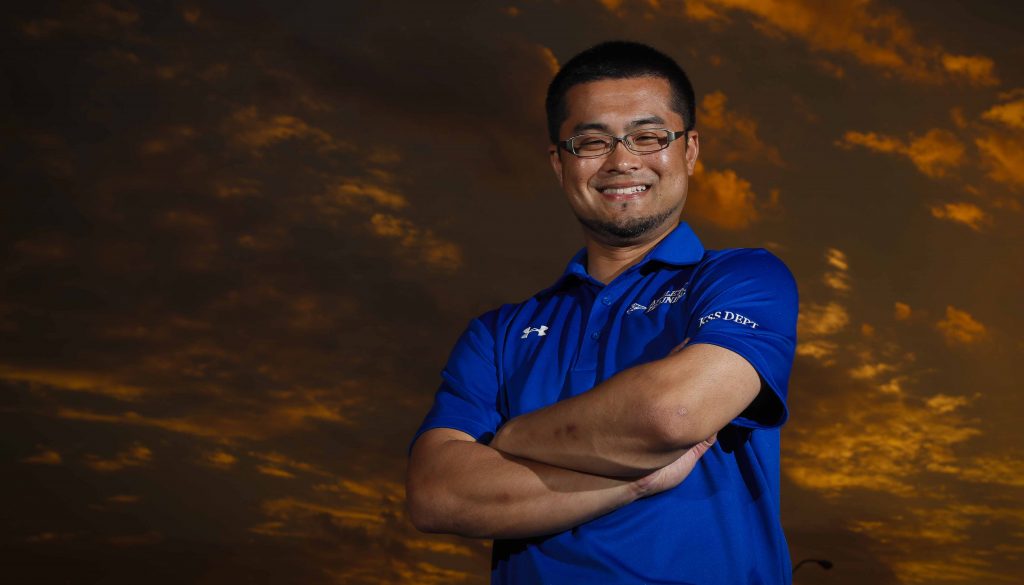
By Sara Giboney, UNK Communications
Growing up in Asahikawa, Japan, Kazuma Akehi spent summers playing basketball, soccer and baseball and winters skiing and snowboarding.
He was always moving his body.
“Obviously we didn’t have smartphones when I was growing up, so outside was our playground,” he said. “I loved running around and chasing the ball with my friends. I simply loved to move. I wanted to be moving all of the time.”
His love for physical activity eventually led him to his groundbreaking research on muscular architecture and neuromuscular changes in college athletes.
Akehi, an assistant professor of kinesiology and sport sciences at the University of Nebraska at Kearney, is currently examining the influence of season-long competitive sport participation on muscular architecture characteristics such as subcutaneous tissue thickness, muscle thickness, pennation angle and echo intensity of muscles.
His research, which he conducts using ultrasounds imaging, aims to assess when an injury will occur during the sports season, how muscles heal using specific therapeutic treatments and whether the muscle can regain its previous thickness and strength.
Akehi came to UNK as a student through an international study abroad agency in 2003. When he arrived, he didn’t speak English. He attended the English Language Institute at UNK before enrolling in general courses.
It was his father, a pharmacist, who encouraged him to study overseas. Akehi developed an interest in medicine as he observed his dad working in the medical field.

Working With Pro Athletes
With his love for physical activity and sports combined with his interest in medicine, athletic training was a perfect fit for Akehi.
He earned his bachelor’s degree in athletic training in 2007.
He then attended the University of Central Oklahoma to begin work on his master’s degree. The University of Central Oklahoma is the home to the United States Paralympic Training Site. Akehi served as an athletic trainer for Paralympic athletes from 2008 to 2014.
“I had a chance to work with a variety of athletes in a variety of situations. That gave me a lot of good experience,” he said. “I learned how to approach different types of athletes, from high school students to college athletes to professional athletes at the international level.”
In addition to working with athletes of varying ages with different needs, many of whom had experienced trauma, Akehi learned about sports medicine all over the world.
He traveled to Russia, Brazil, Canada and Europe with the U.S. Paralympic Team.
Akehi also served as an athletic trainer for the USA Volleyball Association from 2008-14, USA National Sitting Volleyball team from 2008-14, USA Wounded Soldier Training Camp from 2012-14 and USA Volleyball Association High Performance Training Camp in 2012.
He also worked with the Ortho Oklahoma Hospital – Oklahoma High School Outreach Program from 2010-12, the NBA’s Oklahoma City Thunder in 2009 and NBA’s Oklahoma City Thunder Girls Dance Team in 2009 and 2010.
He earned his Master of Science in wellness management with an emphasis in exercise science from the University of Central Oklahoma in 2010, and his Ph.D. in health and human performance with an emphasis in athletic training from Oklahoma State University in 2014.

Diagnostic Ultrasound
At Oklahoma State University, Akehi’s research focused on therapeutic modalities such as Icy Hot, ice packs, heat packs or others. He examined how muscle tightness changed after applying a therapy.
While at Oklahoma State, he also began using diagnostic ultrasound to look at muscle architecture. An ultrasound uses sound waves to create imaging of the internal body structures such as muscles, joints, tendons and internal organs. Akehi used ultrasound on injured athletes to view muscle fibers.
In August 2014, Akehi brought his expertise in using diagnostic ultrasounds to UNK.
“I really wanted to bring what I had learned back to UNK. I had a great experience as a student here,” he said. “I was in Oklahoma for six years, and I experienced so much. I was confident that I could expand UNK’s athletic training program.”
 Akehi’s research at UNK became focused on finding out how muscle architecture and neuromuscular property changes with physical activity.
Akehi’s research at UNK became focused on finding out how muscle architecture and neuromuscular property changes with physical activity.
Muscular morphological adaptation is commonly measured using a tape measure, which doesn’t isolate each muscle and its changes.
Akehi hoped to determine how thigh muscle morphological and architectural characteristics changed throughout the soccer season and how post-knee surgery rehabilitation influenced morphological and architectural characteristics.
“There’s not a lot of people doing this type of research,” he said. “Professional journals often focus on concussions, shoulder problems, knee problems and major injuries. What I’m doing is taking an in-depth look at muscles and nerves.”
He studied 18 female soccer players through an entire season. He took initial measurements of their thigh circumference, subcutaneous tissue thickness, muscle thickness, pennation angle and echo intensity on the rectus femoris, vastus medialis oblique, vastus lateralis, vastus intermedius and biceps femoris muscles. He then measured the athletes every four weeks during the soccer season using the diagnostic ultrasound.
He found that quadriceps and hamstring muscle thickness increased for most during the soccer season and muscle contractile tissue increased in three quadriceps muscles.
In addition to learning how muscles change as a result of training for a sport, Akehi wanted to learn the risk factors for injury during a collegiate sports season. Some athletes failed to adapt their muscle architecture, which means their risk for injury increases.
“Athletes have a high risk for ACL ruptures. Female athletes have three to five times higher risk for injury than male athletes,” he said.
An ACL injury is the over-stretching or tearing of the anterior cruciate ligament in the knee.
Two of the athletes suffered ACL sprains and were continuing post-knee surgery rehabilitation during the study.
“When athletes get injured and have surgery, I can see how the surgery impacts their muscle architecture and how they regain muscle strength,” he said.
Following 12 weeks of post-knee surgery rehabilitation, their muscle tissue measured at the pre-injury stage. This means the rehabilitation and training allowed the athletes to maintain or improve their athletic performance after their injuries. If their muscle architecture hadn’t improved, the physical therapy and training wasn’t effective.
“It’s really unique research. This research provides us with good information that enables us to enhance some of the training or rehabilitation protocols,” he said.
Life After Surgery
Akehi’s findings mean that coaches and trainers of college athletes must consider how season-long college sport participation influences muscle changes and how that relates to performance and injury.
 His final finding was that tape measures did not identify the muscular morphological and architectural characteristics.
His final finding was that tape measures did not identify the muscular morphological and architectural characteristics.
Akehi will continue his research and study both female and male collegiate athletes at UNK.
Akehi is also working on collaborative research projects on improving athletic performance and preventing injuries with colleagues from Texas Tech University, Utah State University, Oklahoma State University, University of Nebraska-Lincoln and University of Nebraska Medical Center.
In a partnership with UNK’s sports medicine program and New West Orthopaedic and Sports Rehabilitation in Kearney, Akehi is studying how specific surgical procedures influence quality of life years after the surgery.
At UNK, Akehi teaches Athletic Training Practicum, Introduction to Anatomical Biomechanics and General Medical Conditions, and Pharmacological Application in Sport and Exercise.
“I wanted to share my experiences with students. I want students to know that there’s no impossible thing. If you have passion and work hard, you can accomplish your goals,” he said.
Akehi continues to be physically active, and he has a passion for rock climbing.
“It’s meditative and relaxing,” he said. “It gives me ideas about the human body and movement.”
Kazuma Akehi
Title: Assistant professor, Kinesiology and Sport Sciences
College: Education
Education: Ph.D., Health and human performance emphasis with athletic training, Oklahoma State University, 2014; Master of Science, Wellness management emphasis with exercise science, University of Central Oklahoma, 2010; Bachelor of Science, Exercise science emphasis with athletic training, University of Nebraska at Kearney, 2007.
Professional Certification: Certified Athletic Trainer

Years at UNK: 2
Career: Graduate assistant, School of Applied Health and Educational Psychology, Oklahoma State University, 2010-14; Graduate assistant, Department of Kinesiology, University of Central Oklahoma, 2008-10.
Hobbies/Interests: Cooking traditional hometown food, climbing rock wall, working in my garage.
Interesting Fact: Akehi has worked as a Certified Athletic Trainer for USA Paralympics and USA Volleyball Association, USA National Sitting Volleyball, USA Wounded Soldier Training Camp, USA Volleyball Association High Performance Training Camp, NBA’s Oklahoma City Thunder Girl Dance Team, Ortho Oklahoma Hospital – Oklahoma High School Outreach Program.
Honors/Awards: 2015 Nebraska Research Initiative Faculty Grant recipient for the project “Impact of Orthopedic Surgery and Rehabilitation on the Lower Extremity Neuromuscular Characteristics, Muscles quality, and Motivation on College Athletes: Cohort Research Study.”
Areas of research/specialization: Athletic injury prevention, Therapeutic intervention before and after musculoskeletal injuries
Courses taught: Athletic Training Practicum, Introduction to Anatomical Biomechanics, General Medical Conditions and Pharmacological Application in Sport and Exercise
Recent Published Articles:
- “Ankle Joint Angle and Lower Leg Musculotendinous Unit Response with Cryotherapy,” Journal of Strength and Conditioning Research, Accepted in 2016 and in process of publication.
- “Reliability of Panoramic Ultrasound Imaging to Simultaneously Examine Muscle Size and Quality of the Hamstring Muscles in Young, Healthy Males and Females,” Ultrasound Medicine & Biology, 2015.
- “The Influence of Athletic Status on Maximal and Rapid Isometric Torque Characteristics and Postural Balance Performance in Division I Female Soccer Athletes and Non-Athlete Controls,” Clinical Physiology and Functional Imaging, 2015.
- “The Identification of Fall History Using Maximal Aand Rapid Isometric Torque Characteristics of the Hip Extensors in Healthy, Recreationally Active Elderly Females: A Preliminary nvestigation,” Aging Clinical and Experimental Research, 2014.
- “Application of Menthol Counterirritant Effect on Hamstring Flexibility, Sensation of Pressure, or Skin Surface Temperature,” Athletic Training and Sports Health Care, 2013.